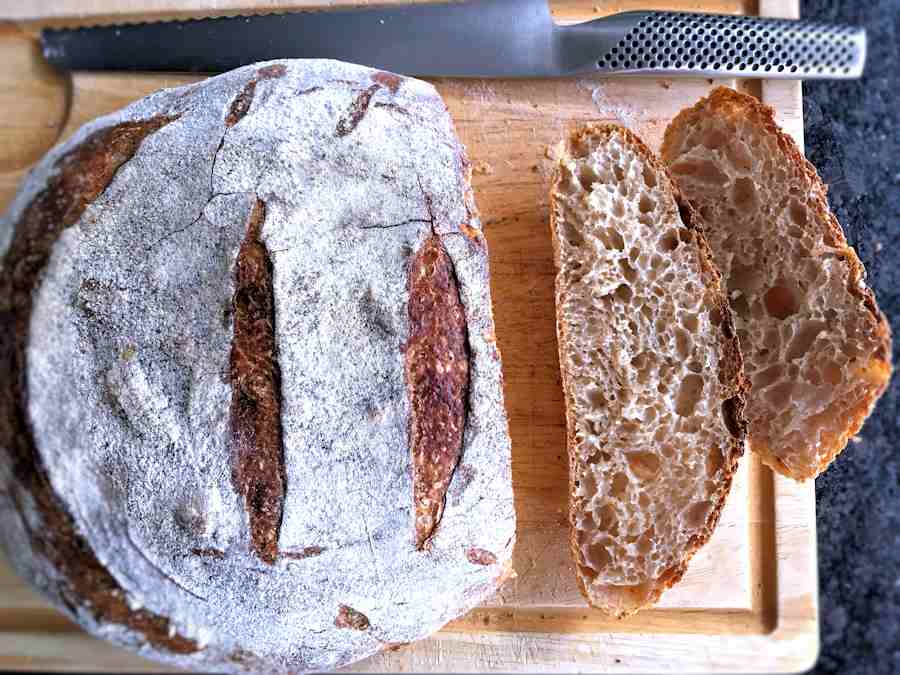Tartine style sourdough country loaf made following one of the best bread recipes: sourdough from Chad Robertson's famous San Francisco Tartine bakery is arguably the best. Includes the unique method of making the sour starter from scratch which takes about a week to mature.

Tartine bread from Tartine Bakery
Tartine Bakery, owned by Chad Robertson and Elisabeth Prueitt, is a place of cult. The queues are allegedly at least an hour long, all day; ‘bread guru’ is a phrase used interchangeably with Robertson’s name and the books ‘Tartine Bread’ and its followers have the status of the Bible, Koran and Torah, combined.
Hashtag your photo #tartine and the Instagram bread porn seekers are your fan club.
The church of bread
My comparison with the holy books is not out of place since in bread, it seems, extremists reign and it’s no place for a moderate. The sourdough fanatics are one axis. They spurn all that’s not wild yeast. Only naturally leavened dough counts.
Show them a drool-inducing croissant and, unless started with a sour, it may as well be a dead rat. Yeast, even baker’s fresh, won’t impress them. And I dare not mention the ultra-orthodox gluten-free sectarians.
... and the bread ignorants
On the other apex, there are folk happily dropping bags of sliced white into their supermarket trolleys. People who eat bread because it’s a filler or a sandwich casing. Those you can never expect to say 'good bread' in any context because for them bread 'just is'.
The people who the Wonder Bread or Hovis White were invented for; the ones who compare good things to sliced bread (only ‘the best thing’ if you slice it yourself) and who are the reason why the Chorleywood process made bread ‘the best food value in Britain’.
Sourdough takes time
I am not a Hovis White eater but try to be open-minded about it – it is, after all, lots of hassle to produce a decent loaf, let alone sourdough. I usually try to split the process and make my sourdough over 3 days, starter notwithstanding.
Some sourdoughs don't like it and insist on being made, shaped, proofed and all in one day. Tartine is brilliant like that - you can easily make it over two or three days.
How to make Tartine country sourdough
The starter takes a week, as starters do. What's interesting about this process, is that after a week of feeding you discard all but a tablespoon of the sourdough starter. What? Indeed - there are whole Facebook groups devoted to what to do with the discard as those good people, me included, feel it's a sin to let a potential for a food down the drain.
But there's only so much you can bake so I persuade myself to get over it, unless I'm planning on baking some honey buns soon.
That spoonful of starter is a greedy beast as, fed with flour and water, it will swell massively overnight. And it wants more: so the next morning it gets the rest of the flour - a mix of white and wholemeal - and has a brief nap called autolyse.
What is autolyse?
In short - hydrating the flour, so the fermentation process is longer and gentler, gluten starts developing slowly and into longer strands, and so subsequently less kneading is necessary. King Arthur discusses it in depth if you're interested.
Folding and folding (and stretching)
Autolyse is followed by kneading but not so intensive. The main part of it is stretching and folding, every half an hour, five or six times. That definitely keeps you cooped up at home for the morning though I've heard stories of keen bakers driving for errands with a bowl of sourdough on the passenger's seat, to give it a little s&f while sat at the traffic lights.
At this stage I usually put it to rest in the fridge for 24 hours. The staggered process is not only easier on your schedule but it also prolongs fermentation in the dough.
Shape and bake
The next day it is shaping the dough into loaves and again - bake right then after a warm proof or store it overnight so you can have freshly baked bread the next morning.
Acknowledgement
I took instruction for my Tartine bread straight from Chad Robertson at NYTimes Cooking. If you know your way around flour, water and levains, give it a go. On the other hand if you do know your way, you’ve sure baked it already and I’ve been lagging behind.